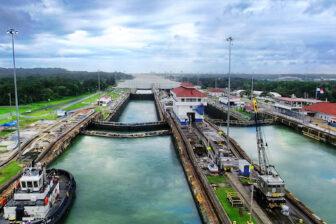Latin America is highly vulnerable to the effects of climate change. Changing precipitation patterns, rising temperatures and increasing frequency of extreme weather all threaten to take a human toll on the region—and also an economic one. Infrastructure will be damaged, tourism reduced and agricultural productivity impacted, threatening food security and exports. Critical industries around Latin America will be hit, from salmon farming in Chile to coffee production in Colombia and cacao production in Ecuador, totaling an estimated $100 billion in damages annually by 2050.
It’s clear that the status quo won’t help the region escape this damage. But neither will it equip the region to benefit from the significant opportunities that will arise from the transition to a low-carbon economy. To do so will require a major rethinking of policy strategy, changing the makeup of Latin American economies, ramping up international cooperation and redirecting government spending.
This won’t be an easy task: financing and borrowing capacity is constrained in the aftermath of the COVID crisis and some leaders in the region may not have the political will—or the vision—to push for this agenda. But in the long run, the cost of doing nothing will be much higher than the cost of a transformative sustainability agenda.
Two sides of the green transition
The global push toward decarbonization brings challenges and opportunities for Latin America’s economies. On the one hand, oil-producing countries like Colombia and Venezuela face uncertainty as fossil fuel demand is expected to drop in the medium to long term, which is projected to cause the loss of over 360,000 jobs across the region.
On the other hand, several Latin American countries are poised to benefit from their large endowment of minerals (such as of lithium, copper, manganese, and nickel) that are essential inputs for low-carbon technologies. But there’s significant uncertainty around the long-term outlook for these minerals, given risks of technological disruption amid global research and development (R&D) efforts globally to generate alternative technologies that rely on substitute materials (such as phosphate-based or hydrogen-based batteries to replace lithium-ion batteries).
Luckily some countries, like Costa Rica, Chile and Uruguay, are ahead of the curve, showing increasingly bold ambitions on climate-related issues, deploying renewables and biodiversity conservation initiatives. But there’s still a lot more to be done to reap the full potential that clean transitions can provide in Latin America.

Pressing an advantage on renewables
By several measures, renewable energy deployment in Latin America is already a success, despite a reliance on hydroelectric generation in several countries that create a vulnerability to droughts. Renewables are the lowest-cost source of new power generation in Chile, Mexico and Peru, and the regional renewable energy capacity per capita is twice the world average—even higher in Paraguay and Uruguay. Three strategies could magnify the region’s progress on renewable energy and put it to work to power economic growth.
First, countries could expand cross-border trade of electricity, which is currently limited. Studies show this would save money and increase the reliability of power grids. Better political coordination is needed to improve congestion mechanisms and harmonize the rules underlying electricity markets.
Second, the region should expand its involvement in higher value-added segments of renewable energy value chains. With the notable exception of Brazil’s biofuel and wind energy sectors, most countries are inserted in lower value-added segments, dealing principally with raw materials (copper, lithium and balsa wood) and supply, installation and maintenance activities.
To blame in part is unstable energy policy in countries like Mexico, where a turn against renewable energy by the Andrés Manuel López Obrador administration has hobbled a bid to expand manufacturing capacity. Moving forward, clearer roadmaps and better long-term energy planning will be key to gain investor trust.
Finally, Latin American countries could make use of abundant, cheap and clean energy to venture into low-carbon services and industries. Green hydrogen production, but also low carbon technology and data services, as well as low carbon mining, will be key to create green jobs and offset expected job losses in the fossil fuel sector.
Leveraging biodiversity protection
When Latin America preserves its carbon-storing rainforest and protects its unique animal and plant species, the whole world benefits. But traditional conservation approaches have often failed to provide benefits to people living in the region.
Better policy efforts are needed to leverage the trade value of biodiversity. This should go far beyond ecotourism which, despite its popularity and importance as a source of revenue and employment in Latin America, poses significant risks, to ecosystems and to revenue stability. In the Galapagos Islands, the COVID crisis generated a 75% drop of tourists in 2020, jeopardizing local livelihoods and the public budget to maintain local ecosystems.
Carbon markets and carbon pricing are one means to generate trade value from biodiversity protection. Putting a price on pollution can be an important source of government revenue: In 2019, governments around the world raised $45 billion this way. Mexico, Chile, and Colombia, have begun to use—or are considering using— carbon pricing and emission trading systems as part of a broader strategy to decarbonize their economies.
But to act as effective trade tools, existing carbon emissions trading systems will need to cut across country and continental boundaries. Latin American jurisdictions need to cooperate to align their carbon markets (like the EU does with Switzerland) to leverage carbon markets as a source of foreign exchange revenues and to receive compensation for ecosystem services from international trade partners – rather than local actors exclusively.
Latin America’s biodiversity also provides a reservoir of the raw material for innovation in agriculture, pharmaceutical goods and ecotourism. Imitating natural processes is already a source of inspiration across economic sectors, but the biodiversity-based innovation sector is underdeveloped in most Latin American countries. Attracting investment should be a top priority.
A regional challenge
National governments, to be sure, will have a prominent role in creating competitive, inclusive, and sustainable economies. They will need to implement a wide range of green industrial policies including R&D support, skills development programs and promotion of low-carbon industrial clusters.
But there’s a limit to how much can be achieved without regional cooperation. Each Latin American country has different strengths, from mineral wealth, to manufacturing expertise, to proximity to important trade routes. All these assets can be part of a carefully designed plan to develop an efficient regional industrial ecosystem around low carbon technologies.
The road to a regional climate action plan is paved with challenges, especially regarding financing and political alignment. But a new pink tide sweeping the region, featuring leaders like Gabriel Boric in Chile and Gustavo Petro in Colombia who have highlighted climate issues in their campaigns, may change the regional dynamic.
The region’s recent success in signing regional agreements, such as the 2018 Escazú Agreement on the right to access environmental information, or the Eastern Tropical Pacific Marine Corridor, announced by four Latin American countries in 2021, also demonstrates the power of regional collaboration. Latin American governments, along with civil society, the business sector and international partners, can and should take bolder steps commensurate with the scale of the opportunities and challenges facing the region.
—
Lebdioui is a development economist and lecturer at SOAS, University of London, and visiting fellow at the LSE Latin America and Caribbean Centre.








